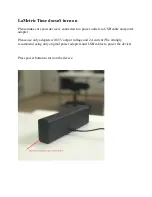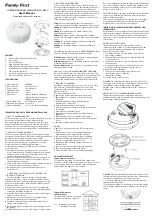
2 / 2
P/N 3101070-EN • REV 05 • ISS 24FEB16
7. Snap a new optical block chamber in place. Make sure you line up
the two arrows on the block chamber with the snaps on the optical
block base.
8. Connect the detector cap to the detector body by rotating the cap
clockwise until it snaps into a locked position.
9. Install the detector onto the base.
Note:
To verify the effectiveness of the cleaning, recalibrate the
device and run a device maintenance report. Refer to the control
panel technical reference manual.
10. Test the detector and verify sensitivity.
Figure 2: Detector disassembly
(1) Slot to insert screwdriver
(2) Optical block chamber
(3) Optical block base
(4) Detector body
(5) Detector cap
Testing
NFPA 72 and CAN/ULC-S537 require a calibrated sensitivity test upon
installation and following any modifications or additions to the system.
The detector can perform this test and generate a system sensitivity
report.
To test the detector:
1. Before initial testing, remove the dust cover from the detector and
notify the proper authorities that the fire alarm system is
undergoing maintenance and will be temporarily out of service.
2. Test the detector using Smoke-In-A-Can (model SM-200) canned
smoke. Carefully follow directions on the can to avoid damage to
the detector.
Specifications
Communication line
voltage
20 Vp-p max.
Current
Normal
operating
Alarm
45 µA
45 µA
Smoke sensitivity
UL
ULC
0.67 to 3.66 %/ft. obscuration
0.74 to 3.70 %/ft. obscuration
Environmental
compensation
Automatic
Distance from ceiling
(wall mounted)
12 in. (305 mm) max.
Compatible bases
Standard
Relay
Isolator
Audible
B4U, B4U-LP
RB4U
IB4U
SB4U, SB4U-LF
Operating environment
Temperature
Relative
humidity
32 to 120°F (0 to 49°C)
0 to 93% noncondensing
Storage temperature
−
4 to 140°F (
−
20 to 60°C)
Regulatory information
North American
standards
Meets: CAN/ULC-S529, UL 268
Follow: CAN/ULC-S524, CAN/ULC-S537,
National Building Code of Canada
,
National Fire
Code of Canada
, and NFPA 72
FCC compliance
This device complies with part 15 of the FCC
Rules. Operation is subject to the following two
conditions: (1) This device may not cause harmful
interference, and (2) this device must accept any
interference received, including interference that
may cause undesired operation.
Industry Canada
compliance
This Class A digital apparatus complies with
Canadian ICES-003.
Contact information
For contact information, see www.kiddelifesafety.com.
© 2016 Walter Kidde Portable Equipment, Inc.
All rights reserved.
(1)
(2)
(5)
XX
XX
XX
XX
(3)
(4)




















